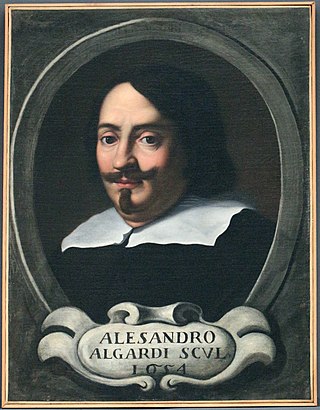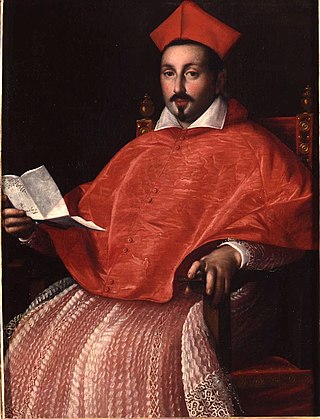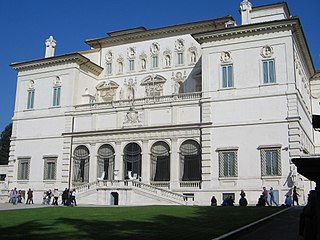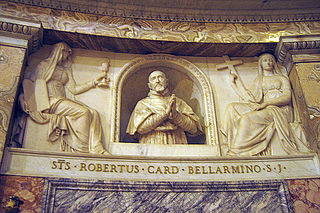
Alessandro Algardi was an Italian high-Baroque sculptor active almost exclusively in Rome. In the latter decades of his life, he was, along with Francesco Borromini and Pietro da Cortona, one of the major rivals of Gian Lorenzo Bernini, in Rome. He is now most admired for his portrait busts that have great vivacity and dignity.

Gian LorenzoBernini was an Italian sculptor and architect. While a major figure in the world of architecture, he was more prominently the leading sculptor of his age, credited with creating the Baroque style of sculpture.

The Galleria Borghese is an art gallery in Rome, Italy, housed in the former Villa Borghese Pinciana. At the outset, the gallery building was integrated with its gardens, but nowadays the Villa Borghese gardens are considered a separate tourist attraction. The Galleria Borghese houses a substantial part of the Borghese Collection of paintings, sculpture and antiquities, begun by Cardinal Scipione Borghese, the nephew of Pope Paul V. The building was constructed by the architect Flaminio Ponzio, developing sketches by Scipione Borghese himself, who used it as a villa suburbana, a country villa at the edge of Rome.

Scipione Borghese was an Italian cardinal, art collector and patron of the arts. A member of the Borghese family, he was the patron of the painter Caravaggio and the artist Bernini. His legacy is the establishment of the art collection at the Villa Borghese in Rome.

Pietro Bernini was an Italian sculptor. He was the father of one of the most famous artists of Baroque, Gian Lorenzo Bernini, as well as the sculptor-architect Luigi Bernini.

Aeneas, Anchises, and Ascanius is a sculpture by the Italian artist Gian Lorenzo Bernini created c. 1618–19. Housed in the Galleria Borghese in Rome, the sculpture depicts a scene from the Aeneid, where the hero Aeneas leads his family from burning Troy.

Apollo and Daphne is a life-sized marble sculpture by the Italian artist Gian Lorenzo Bernini, which was executed between 1622 and 1625. It is regarded as one of the artistic marvels of the Baroque age. The statue is housed in the Galleria Borghese in Rome, along with several other examples of the artist's most important early works. The sculpture depicts the climax of the story of Apollo and Daphne, as written in Ovid's Metamorphoses, wherein the nymph Daphne escapes Apollo's advances by transforming into a laurel tree.

The Borghese Collection is a collection of Roman sculptures, old masters and modern art collected by the Roman Borghese family, especially Cardinal Scipione Borghese, from the 17th century on. It includes major collections of Caravaggio, Raphael, and Titian, and of ancient Roman art. Cardinal Scipione Borghese also bought widely from leading painters and sculptors of his time, and Scipione Borghese's commissions include two portrait busts by Gian Lorenzo Bernini. Most of the collection remains intact and on display at the Galleria Borghese, although a significant sale of classical sculpture was made under duress to the Louvre in 1807.

Villa Borghese Pinciana is a villa built by the architect Flaminio Ponzio, developing sketches by Scipione Borghese.

The Sleeping Hermaphrodite is an ancient marble sculpture depicting Hermaphroditus life size. In 1620, Italian artist Gian Lorenzo Bernini sculpted the mattress upon which the statue now lies. The form is partly derived from ancient portrayals of Venus and other female nudes, and partly from contemporaneous feminised Hellenistic portrayals of Dionysus/Bacchus. It represents a subject that was much repeated in Hellenistic times and in ancient Rome, to judge from the number of versions that have survived. Discovered at Santa Maria della Vittoria, Rome, the Sleeping Hermaphrodite was immediately claimed by Cardinal Scipione Borghese and became part of the Borghese Collection. The "Borghese Hermaphrodite" was later sold to the occupying French and was moved to The Louvre, where it is on display.

The Rape of Proserpina, more accurately translated as The Abduction of Proserpina, is a large Baroque marble group sculpture by Italian artist Gian Lorenzo Bernini, executed between 1621 and 1622, when Bernini's career was in its early stage. The group, finished when Bernini was just 23 years old, depicts the abduction of Proserpina, who is seized and taken to the underworld by the god Pluto. It features Pluto holding Proserpina aloft, and a Cerberus to symbolize the border into the underworld that Pluto carries Proserpina into.

Truth Unveiled by Time is a marble sculpture by Italian artist Gian Lorenzo Bernini, one of the foremost sculptors of the Italian Baroque. Executed between 1645 and 1652, Bernini intended to show Truth allegorically as a naked young woman being unveiled by a figure of Time above her, but the figure of Time was never executed.

Two Busts of Cardinal Scipione Borghese are marble portrait sculptures executed by the Italian artist Gian Lorenzo Bernini in 1632. Cardinal Scipione Borghese was the nephew of Pope Paul V, and had commissioned other works from Bernini in the 1620s. Both versions of this portrait are in the Galleria Borghese, Rome.

The Statue of Pope Clement X is one of the final sculptural works executed by the Italian artist Gian Lorenzo Bernini. It depicts Pope Clement X in the act of benediction, and is housed in the Galleria Nazionale d'Arte Antica in the Palazzo Barberini, Rome.

The Bust of Cardinal Roberto Bellarmine is a half-length portrait of Saint Robert Bellarmine by the Italian artist Gian Lorenzo Bernini. It was executed in the years 1621–1624, and unveiled in August 1624. It sits in the Chiesa del Gesù, Rome. It was commissioned by Pope Gregory XV and Cardinal Odoardo Farnese after Bellarmine's death. A tomb (now-destroyed) surrounding the bust was designed by Girolamo Rainaldi, and included sculptural decoration by Bernini's father, Pietro, and Bernini's some-time assistant, Giuliano Finelli.

The Bust of Pope Gregory XV is a marble portrait sculpture by the Italian artist Gian Lorenzo Bernini. Executed in 1621, the work is one of three busts of the subject created by Bernini—the other two were bronze casts. The marble bust is on permanent display at the Art Gallery of Ontario, in Toronto. It was donated to the museum by Joey and Toby Tanenbaum.

Charles I in Three Positions, also known as the Triple Portrait of Charles I, is an oil painting of Charles I of England painted 1635–1636 by the Flemish artist Sir Anthony van Dyck, showing the king from three viewpoints: left full profile, face on, and right three-quarter profile. It is currently part of the Royal Collection.

The Busts of Pope Innocent X are two portrait busts by the Italian artist Gianlorenzo Bernini of Pope Innocent X, Giovanni Battista Pamphili. Created around 1650, both sculptures are now in the Galleria Doria Pamphili in Rome. Like the two busts of Cardinal Scipione Borghese, it is believed that Bernini created a second version of the bust once a flaw was discovered in the first version. There exist several similar versions of the bust done by other artists, most notably Alessandro Algardi.

Several sculpted busts of Pope Urban VIII were created by the Italian artist Gianlorenzo Bernini, with varying amounts of assistance from other artists in his workshop:
- Palazzo Barberini, Rome, 1623–1624. Marble.
- San Lorenzo in Fonte, 1626. Marble. Assistance by Giuliano Finelli.
- Galleria Nazionale di Arte, Palazzo Barberini, Rome, 1637–1638. Marble.
- Galleria Nazionale di Arte, Palazzo Barberini, Rome. Early 1640s. Marble. Largely the work of an assistant.
- Louvre, Paris. 1640. Bronze.
- Cathedral of Spoleto, 1642. Bronze.
- Collection Principe Enrico Barberini. Early 1640s. Porphyry. Adapted from existing antique statue, largely by assistants.
- Private Collection. 1658. Bronze
Boy with a Dragon is a c. 1617 white marble sculpture, now in the Getty Museum, which has owned it since 1987. It draws on the myth of the infant Hercules strangling serpents sent to kill him.


















